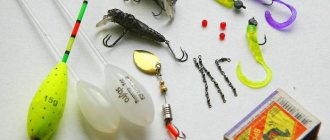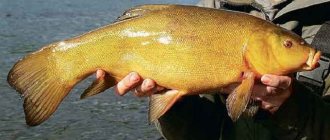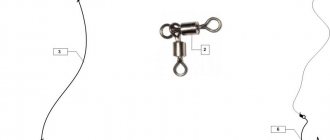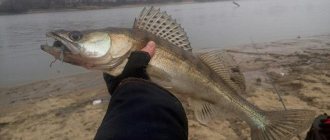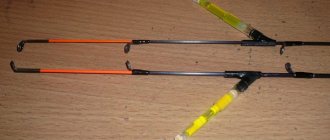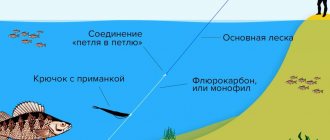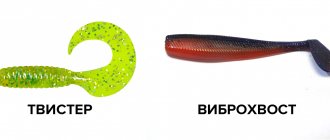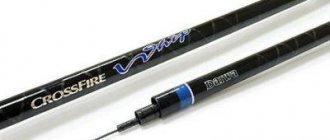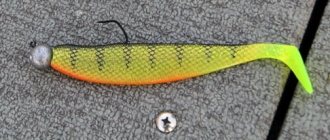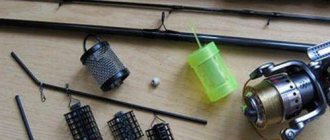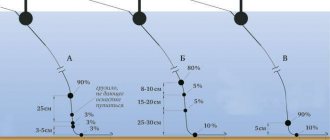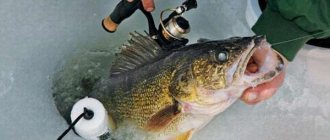Texas rig is one of the most popular spaced rigs, which has become widespread among our spinning players. It is aimed at difficult to navigate places and is used for hunting perch, pike perch and pike, which in large numbers inhabit snags and overgrown areas of reservoirs.
Texas equipment appeared in the middle of the last century. It was developed by North American anglers who love to catch largemouth bass. It allowed them to successfully fish the tough spots that bass love without losing their lures too much due to snags.
Having fallen into the hands of our spinning anglers, the Texas quickly became in demand, since the perch appreciated it properly. With the help of this equipment, anglers were able to “break through” previously hard-to-reach places where striped fish are found in abundance. Having made the installation a little heavier, which made it possible to fish on snags in deep holes, it was time for pike perch, pike and catfish.
Advantages of Texas equipment
Texas equipment is classified as a spaced type of installation. It consists of a bullet weight that moves freely along the fishing line, a bead, an offset hook and a silicone nozzle.
The main advantages of Texas equipment are:
- Easy and quick installation;
- Good catchability;
- Ability to use various wiring methods and their combinations;
- Excellent cross-country ability in cluttered areas, which is achieved due to the presence of a bullet load;
- Good range;
The Texas rig works well on passive fish; by retrieving it slowly, we provoke a predator standing in the shelter to attack, and besides, when swallowing the bait, the fish does not feel the weight of the sliding sinker.
At the same time, when the Texas rig is mounted on an active predator, it is no less catchy.
Fishing with Texas rigs is effective both in still waters and in the current.
What is Texas equipment and where is it used?
The Texas rig is designed quite simply - an offset hook with a silicone worm attached to it is tied to the main fishing line, on which a bullet-shaped sinker slides. A bead (beads) is installed between the hook and the bullet. Although its presence is not always necessary, more on that later.
Thanks to the use of a bullet-shaped sinker and an offset hook in the rig, the Texas rig has increased cross-country ability and is used primarily in heavily overgrown or snagged areas of the reservoir, where other rigs or baits simply have no chance of retrieving. The hook tip is securely hidden in the bait, and the shape of the sinker almost completely eliminates jamming between stones or branches under water. And you need to try very hard to “plant” the bait in the Texas rig.
It is worth saying that with the Texas rig you can successfully catch a predator throughout the open water season, on any type of reservoir. And by changing the weight of the sinker, you can fish literally all layers of water.
Texas snap montage
You can buy a bait with ready-made Texas equipment in a store, but it is better to learn how to make it yourself, this will give you the opportunity to quickly change the equipment, adapting to different fishing conditions.
So, we knit the rig:
- A piece of fluorocarbon fishing line, 1-1.5 m long, is connected to the main fishing line using a swivel or loop-to-loop installation. When hunting pike, a flexible metal bait is used.
- We put a sinker on the leash, but so that its pointed part faces the direction of the rod;
- Next we string the bead;
- We tie the offset hook using a “clinch” or “palomar” knot (for the “palomar” knot it is important that the eye of the hook is wide enough to allow the doubled fishing line to pass through);
- Now all that remains is to attach the bait to the offset and the installation of the Texas rig is ready.
If you do not use a leash, then everything is knitted in the same sequence, but directly on the main line.
Clinch
Modern tackle
Today, spinners tend to use rigs that differ significantly from the classic look of the original Texas. Instead of the bullet weight designed specifically for the Texas rig, other shaped weights such as olives .
The plastic bead is often replaced with a silicone stopper or removed from the equipment altogether. Instead of the Texas Hook , which is designed for use with lures with narrow bodies, Wide Gap hooks . twisters and vibrotails to them which are most often used for catching pike.
The peculiarity of the Texas equipment for pike fishing is that it cannot be assembled directly on the main line. Installation must include a leash, which this predator cannot bite with its sharp teeth.
Texas rig lures
It is best to use various edible versions of silicone tips. They must be narrow-bodied; they can be either passive or active.
Passive (not having their own game):
- Worms;
- Octopuses;
- Slugs;
- Creators;
Active:
- Vibrotails;
- Twisters
Which bait to choose for mounting on a Texas rig depends on the degree of activity of the fish? The higher it is, the brighter the animation should be on the attachment.
Texas rigs work better with baits made of floating silicone, which can stretch 6-8 times. This silicone is quite wear-resistant, holds well on the hook and can withstand a large number of bites.
As you know, when fishing with offset, it is the front part of the bait that most often suffers, and if you use ordinary rubber, it will have to be changed often, but stretchy rubber will last for almost a whole day of fishing.
Continuing the topic of Texas rig mounting, I would like to mention that the size of the bait depends on the size of the trophy. So, perch is caught well with worms 5 to 7 cm long and vibrotails 2-5 cm. Pike perch chooses larger baits: worms 9-11 cm and vibrotails 5 to 7 cm. Large worms (from 12 cm) are taken for pike ) and vibrotails (from 7 cm).
Lures for fishing
When collecting, many people pay attention to worms, which are made of silicone. The choice of bait depends on the reservoir, food supply, and which fish is preferred.
Attention should be paid to the fact that all silicone baits are divided into two main categories:
- Active. They are characterized by the fact that they have a twister tail, which provides oscillation at the time of posting. The product is characterized by increased efficiency in use.
- Passive. Such baits do not have their own game. Therefore, attention should be paid to correct wiring.
Let's celebrate! It is recommended to purchase both options and choose them depending on the conditions in which the fishing is carried out. They are suitable for catching non-active fish, but an active predator pays attention to such bait because of its edible qualities.
Tackle for fishing with Texas rig
Rod
Fishing with a Texas rig is more of a jig fishing, so the appropriate forms are chosen. When fishing in large bodies of water with great depth, fast or ultra-fast action blanks with high power and high sensitivity are used. On small rivers and ponds you can use light class rods with medium action.
Coil
When fishing in difficult areas (snags, algae), it is dangerous to give the fish freedom of action; here our main task is to bring the fish to the boat or shore as quickly as possible. For these purposes, power inertia-free or multiplier coils are used. In other cases, you can use a faster inertia-free coil. For long casts, the quality of line laying is very important. Don't forget about a good clutch.
fishing line
Most anglers prefer braided fishing line, since one of the most catchy jig fishing methods is to slowly drag the bait along the bottom, and here braid has no equal. True, there are a number of anglers who fish with monofilament and fluorocarbon fishing lines. Fluorocarbon is great for Texas rigs because it is less susceptible to damage and abrasion from various hard and sharp objects.
How to catch pike perch using a rig?
The fishing technique is chosen primarily based on the conditions.
Let's look at a few different examples:
- Heavy thickets and rocks. In order to eliminate the possibility of a snag, similar equipment is used. Stepped jig wiring is used, which is characterized by long pauses. Many perform a slight toss of the bait, which ensures an attractive game.
- Driftwood and other debris. In such conditions, the most suitable technique is one that is based on slowly dragging the sinker onto the branch. In this case, a pause is maintained, after which the equipment is dropped. No predator can resist such a movement. It is snags that often become places where predatory fish look for their prey.
- Fishing in the grass. In such a case, stepwise wiring is carried out. In some cases, the grass covers the bottom in an almost even layer, so turntables and shakers are more effective.
- Reservoirs with a clean bottom. Often, experienced fishermen use the step method or dragging the bait.
Do not forget that high fishing efficiency when choosing the appropriate equipment is ensured in still water and strong currents.
Fishing with a Texas rig
Some features of hooking
If you carry out the retrieval by pulling the rod (fishing with casting tackle, in places where there are hooks), then it may happen that the bite will occur at the moment when your rod is raised above your head. It is extremely inconvenient to hook from such a position; at best, we will hook by throwing the rod over our head.
In this case, it is better to lower the fishing rod down, reel in the fishing line and then make a jerk, spotting the fish. At the same time, the pause that we will have will allow the fish to better swallow the bait.
Perch
Relatively small baits up to 5-7 cm and light weights are recommended. When retrieving, you must be very careful, since in most cases the attack of the perch on the bait is weak,
in the form of neat pokes, disturbances in the game of the bait and twitching. Of the wiring, it is preferable to pull the equipment along the bottom, which periodically changes with jerking wiring and pauses of different periods of time.
Texas rig mounting for walleye
Pike perch prefers depth, so the weight of the load must be heavier than when hunting for pike and perch. The size of the bait is up to 7-11 cm. The offset hook is chosen to be hard and durable so that it can penetrate and hook the hard upper jaw. A step in combination with a dotted line is used as wiring. The bite of medium-sized pike perch is often also not pronounced, and is somewhat similar to perch.
Texas on pike
One of the main differences when installing Texas rigs on pike is the presence of a thick fluorocarbon leader or steel cable. When fishing for pike in thickets of grass, you should under no circumstances use snap hooks; all gear should have a minimum of protruding elements. The baits used are larger than when fishing for pike perch, while the weight of the sinker is relatively light, which makes the bait more realistic. Stepped and wavy wiring works well.
Wiring
Texas equipment is quite versatile and allows you to combine different types of fishing rods, which we will use, adapting to different fishing conditions.
- In places where there are no hooks, stepped, uniform or fast retrieving works well, as well as dragging the bait along the bottom.
- In rocky areas and snags, retrieving is done by smoothly pulling the rod.
- If the bottom is evenly covered with a layer of algae of the same height, then you can use lines operating in the water column (uniform and pelagic) to guide the bait above the algae.
- In snag, you can also use a rather dangerous but effective method. For these purposes, light loads are selected. The essence of wiring is that we carefully drag the bait onto a branch of a flooded snag, and then give it the opportunity to fall from it to the bottom.
If the bait gets caught on a branch, under no circumstances should you begin to forcefully pull it towards yourself in an attempt to push through the obstacle. On the contrary, we loosen the tension and let the bait fall back. Then we try to overcome the obstacle, either by moving along the shore to the side, or by throwing the bait up with the rod.
Fishing Features
The main feature of fishing with Texas equipment is the possibility of using it in hard-to-reach places , such as snags and grass thickets, or in places where fishing is always accompanied by hooks (shell rocks and rocky banks). When mounting a silicone bait on an offset hook so that the hook point is closed, the Texas rig provides almost 100% passability .
The absence of any elements that can catch the grass allows you to use Texas equipment even when fishing among filamentous algae (mud). Another feature of the Texas rig is its wide range of silicone lure selection capabilities . Initially, the main bait for fishing with Texas equipment was a silicone worm, and its passive version, i.e. a worm without a twister tail.
In our conditions, you can use both passive baits - worms, slugs, creatures, and more active ones - twisters and vibrotails. The choice depends on the intended target of the hunt, the activity of the predator and the fishing conditions. As is clear, the less active the fish, the more passive the bait should have.
Installation elements
Sinker
The sinker for the Texas rig has the shape of a bullet with a through axial hole. At the back of the sinker there is a recess into which the bead and eye of the hook are hidden on a fully assembled rig. Sinkers are made of tungsten, brass, but mainly lead.
Expert opinion
Knipovich Nikolai Mikhailovich
Zoologist, hydrobiologist. I am interested in fishing at a professional level.
Healthy. A lead sinker for a Texas rig can be made at home. This requires a plaster mold, the manufacture of which does not present any particular difficulties.
Hooks
Since Texas rigs are typically used in difficult fishing conditions, offset hooks . The point of the hook must be hidden in the body of the bait, and this can only be effectively achieved with an offset hook. On a clean bottom, you can use regular single hooks , leaving the tip open. The hook size is selected in accordance with the size of the bait and the size of the intended prey.
Bead
The bead is installed on the fishing line between the hook and sinker and performs two functions:
- prevents the knot from being broken by the sinker;
- helps create a noise effect when wiring equipment.
The materials from which the beads are made are:
- plastic;
- glass;
- brass.
Leashes
When fishing with Texas rigs, leashes are used in two cases:
- when fishing in accumulations of shell rock;
- when hunting pike.
In the first case fluorocarbon , since it has increased abrasion resistance. It can also be used as a leader material when fishing for pike, but metal leaders will be much more reliable . To make a leader, you can use either soft leader material or a hard string - the main thing is that the sinker slides smoothly along the leader.
How to play?
Texas equipment offers several types of games. Briefly they can be described as follows:
- Wiring in steps. In this case, the load is first lowered to the bottom, then the reel begins to slowly wind, which lifts the load above the bottom. Then it is lowered again, unwinding the fishing line using a reel. With such a game, there are no unnecessary sounds, the fish are not scared again, and the game is attractive.
- Wiring is jerky. Here the reel is not involved, another part of the spinning rod is working, namely the nod. It must be sharply raised up, and then the weight should be allowed to fall to the bottom, allowing the bait to “fly” freely to the bottom.
- Zigzag wiring. The name of the game speaks for itself. The load is moved from side to side in a zigzag motion.
When playing with a Texas rig, movements must be measured, sometimes even smooth, otherwise the wiring will not work.
The Texas Rig is good for fishing at shallow depths. It also works great in overgrown areas of the reservoir, since “Texas” has offset hooks that are perfectly masked with silicone.
The hook with bait passes smoothly through thickets of water lilies or reeds, where predatory fish like to accumulate. Seeing attractive prey, even the most passive fish is sure to become more active.
It is worth saying that Texas Rig has some disadvantages. For example, for a fish to be hooked, it must swallow the silicone, or at least squeeze the silicone tightly with its mouth. Not every fish is capable of this. Because of this, derailments may occur frequently, but there is still a way out. You can use edible bait options.
Selection of baits
Whenever you go to a body of water, you can use rotating decoys. But we must understand that such products can still fail under certain conditions. The “turntables” of the French brand “Meps” are in demand. Compared to competing products, they are inexpensive - but without any compromise on quality. The bottom layer of reservoirs in search of perch is often fished with silicone and edible rubber.
Dough is often used for homemade baits. There are no difficulties in preparing it - you can use any recipe. Sometimes oatmeal is also mixed with vegetable oil to increase the viscosity of the product. The best cereal porridges are:
- pearl barley;
- semolina;
- barley;
- millet
Among animal baits we recommend:
- worms;
- maggots;
- bloodworms;
- "sandwiches";
- "twisters";
- independently collected beetles, larvae, caterpillars.
Speaking about spinners, one cannot ignore the Mepps Aglia, which has been popular for several years. It is worth considering that complaints about this model are related to the abundance of counterfeit copies - and therefore buying in specialized stores is the best solution.
Smith Niakis is a great alternative. Such a long-range spinner guarantees successful fast or slow retrieve. But the design still performs better at low speed. The petal is designed to reduce the likelihood of snagging. The model is recommended for streams and small rivers.
In some cases, vibrating tails are used. The following requirements apply to them:
- small dimensions;
- excellent own game;
- optimal color (preferably red tone);
- narrowed shape.
Installation
Installation of Texas equipment is carried out as follows. First, the main line is threaded through the sinker hole, then a bead is put on it, and after that the hook is tied. To tie a hook, we can recommend a simple and reliable “clinch” knot. When using a leash, all equipment is mounted on it.
Expert opinion
Knipovich Nikolai Mikhailovich
Zoologist, hydrobiologist. I am interested in fishing at a professional level.
Important! The recess in the back of the sinker should be large enough to accommodate the bead and eye of the hook, or at least most of it. This is necessary to prevent the protruding elements of the eyelet from getting caught in the grass.
For zander
Texas rig when fishing for pike perch is used when fishing:
- in snags;
- in shell rocks;
- in scatterings of stones;
- occasionally in thickets of bottom grass.
Pike perch very often chooses the listed hard-to-reach places as parking and hunting sites. "Texas" is the most effective equipment with which you can catch a predator in such conditions. No special properties are required from the installation of Texas equipment when fishing for pike perch; the basic option will do just fine; only when fishing on shell rocks is it advisable to use a fluorocarbon leader.
For pike
Pike also chooses the above-mentioned places for ambushes, but often grass thickets are its priority. When fishing for pike, a leash is a necessary element of equipment. When fishing in “toad beds,” the equipment must be mounted extremely carefully so that not a single element of it clings to the grass, i.e., no fasteners should be present in the equipment.
For perch
Perch, like other predators, loves hard-to-reach places, but does not neglect areas with a clean bottom. In such places it can be caught using baits attached to a hook in the usual way, i.e. with the hook tip sticking out.
Installation of Carolina equipment
So, in our hands we have an unequipped end of a fishing line or cord. The first thing we will mount on it according to the “Carolina” technology is a sinker.
Sinker
According to the standard American system, as we have already said, the shape of the sinker should be bullet-shaped. However, our fishermen often neglect this issue and install simple “olives”, declaring that they do not notice the direct influence of the shape of the sinker on the catchability of the equipment.
As for the material of the sinker, there are three most famous ones for this type of equipment: lead, brass and tungsten. This issue is worth understanding in more detail.
Lead. This is the most common material and at the same time the most inexpensive. Most fishermen use it in almost any conditions: even grass, even driftwood, even stones.
Brass. The sinker, made of brass, according to the Americans, gives that very click on the bead, which attracts a predator from a very long distance. But there is a small nuance here - a brass sinker is significantly lighter than a lead one, which means it is suitable for fishing in relatively shallow reservoirs without a significant current.
Tungsten. A sinker made from this material is ideal for this type of equipment. It has many advantages: significant weight, small volume, flies well, “knocks” perfectly on stones and shells. However, it has one drawback - it cannot always be found in our fishing stores.
Bead
Next “on the list” for the “Carolina rig” is a bead, for which the Americans have two main requirements: high resistance to shock loads and an acoustic effect.
During the casting process, the load will constantly hit the bead with varying force, so it must be highly resistant to shock loads. Otherwise, the bead may simply fall apart after a couple of hits, and this is a waste of precious time for re-equipment.
The acoustic effect is only important if the sinker was chosen from brass. Let us remind you that Americans recommend using beads in combination with brass. But as for our domestic fishermen, their opinion is radically different from their American colleagues. According to Russian fishermen, the presence of a bead is not necessary. The acoustic effect is a fiction, and the shock-absorbing, saving swivel is superfluous. No one will make so many casts that the bullet will break the knot or wear out the line. Much faster, the fisherman will catch the hook, with the subsequent separation of the bait.
Swivel
There are no supernatural requirements for this element, the most important thing is that it is strong, reliable and rotates freely and does not allow the bait to twist the leash.
Leash
After the swivel there is such an element of the “Carolina rig” as a leash. Recently, most fishermen use fluorocarbon line for this element. The length of the leash is determined primarily by the activity of the fish and fishing conditions. Most often it is 0.7 - 1.3 m. By the way, some fishermen notice that the more passive the predator, the longer the leash should be.
As for the diameter of the leash, there is one nuance - this is the breaking load. It should be smaller than that of the main fishing line or cord. When hooked, only the bait will come off, and not the entire set, along with the bullet.
Hook
“Carolina rig” was invented for reservoirs where increased cross-country ability and non-catching bait are the main factors. This means that the hooks most often found in this equipment are offset ones.
Bait
Traditional Carolina rig baits include a variety of active and passive plastic worms.
Most fishermen also advise using only edible rubber in this matter. The thing is that a predator can pick up bait from the bottom unnoticed by us, and we can’t always feel it. Therefore, the use of “edible” helps us out a lot, because the predator does not immediately spit out the bait, but keeps it longer in its mouth. And this is already a good chance to feel the poke and hook the fish.
Lures
In principle, with Texas equipment you can fish with any type of silicone baits, but still those that have passive action or do not have it at all are more often used, namely, silicone worms and slugs.
When catching an active predator, ordinary twisters and vibrating tails are quite suitable, but in a situation where the fish is in a “bad mood” one cannot do without the use of passive type baits, which require the angler to master various methods of their animation. The edibility of the bait plays an important role, especially when fishing for pike perch and pike perch.
